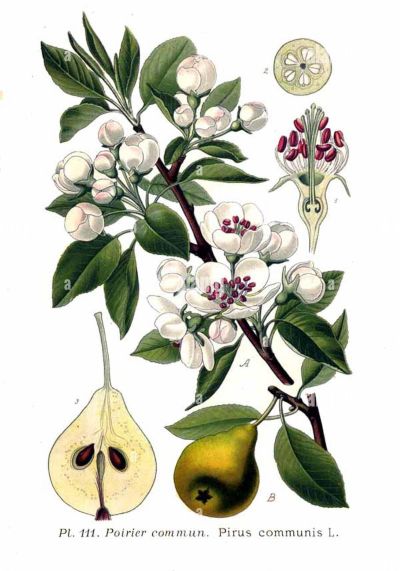Common Pear
Common Pear
Pyrus communis L.
Rosaceae Family
Description of Pear
Common pear tree shrub 16–66 ft (5–20 m) gray-brown bark spreading crown. Leaves alternate oval 0.8–3.1 in (2–8 cm) glossy dark-green yellow autumn. Flowers white 0.8–1.2 in (2–3 cm) corymb inflorescences (5–12). Fruits pear-shaped round 2–5.9 in (5–15 cm) green yellow reddish juicy pulp small seeds (5–10). Varieties ‘Conference’ ‘Beurre Bosc’ ‘Forest Beauty’. Blooms April–May fruits August–October.
Distribution and Ecology of Pear
Native Europe Western Asia. Grows temperate Russia Ukraine Caucasus Central Asia 3280 ft (1000 m). Cultivated Europe Asia North America Australia. Loamy soils (pH 6.0–7.0) sunny water 5.3–7.9 gal/tree (20–30 l) every 10–14 days. Grafting cuttings seeds. Yield 110–220 lb/tree (50–100 kg). Prune phosphorus (20–30 g/m²) scab codling moth. Landscaping honey plant.
Raw Materials from Pear
Fruits (fructus Pyri) leaves (folia Pyri) seeds (semen Pyri). Fruits August–October dry 104–122°F (40–50°C) 15–20%. Leaves June–July 104°F (40°C) 20–25%. Seeds extract dry 86–104°F (30–40°C) 5–10%. Quality fruits no mold leaves green seeds brown humidity ≤12%. Store airtight fruits 1 year leaves 1 seeds 2. Sweet smell sour-sweet taste.
Chemical Composition of Pear
Fruits water (85%) sugars (12%) organic acids (malic citric 1%) pectins (2%) vitamin C (10 mg%) A B1 B2 E folic flavonoids minerals (K Ca Fe). Leaves flavonoids arbutin tannins (2%). Seeds fat oil (20%) amygdalin. Calories 40–50 kcal/100 g.
Uses and Benefits of Pear
Diuretic anti-inflammatory astringent antiseptic tonic. Kidneys bladder anemia gastritis diarrhea cold hypertension. Fruits digestion flora. Leaves urinary inflammation dermatitis. Juice fever vessels. Seeds (small) cough.
Precautions for Using Pear
>3.3 lb/day (1.5 kg) fruits >10 oz/day (300 ml) juice flatulence diarrhea. Seeds >0.18 oz/day (5 g) toxic amygdalin nausea dizziness. Juice 32–41°F (0–5°C) 24 hours. Children under 3 ≤1.76 oz/day (50 g). Ripe unripe upset. Wash pesticides.
Contraindications for Using Pear
Rosaceae allergy chronic constipation high-acid gastritis ulcer exacerbation pregnancy lactation.
Medicinal Recipes with Pear
- Leaves decoction cystitis. 0.35 oz (10 g) leaves 6.8 oz (200 ml) boiling boil 10 min drink 1.7 oz (50 ml) 2 times day 7 days.
- Juice anemia. 3.4 oz (100 ml) juice 2 times day 10 days.
- Seeds infusion cough. 0.11 oz (3 g) seeds 3.4 oz (100 ml) boiling steep 20 min drink 1.7 oz (50 ml) 2 times day 5 days.
- Poultice dermatitis. 0.7 oz (20 g) pulp apply 15 min rinse 2 times day 5 days.
Cosmetic Uses of Pear
Skin hair care.
- Hydrating mask. 0.7 oz (20 g) pulp 0.35 oz (10 ml) honey apply 15 min rinse 2 week.
- Oily skin lotion. 0.7 oz (20 ml) juice 0.35 oz (10 ml) water wipe 1 day.
- Hair mask. 0.7 oz (20 g) pulp 0.35 oz (10 ml) olive apply hair 20 min rinse weekly.
- Leaves infusion acne. 0.35 oz (10 g) leaves 3.4 oz (100 ml) boiling steep 20 min wipe 2 day.
Culinary Uses of Pear
Fresh dried desserts drinks.
- Compote. 10.6 oz (300 g) fruits 33.8 oz (1 l) water 1.76 oz (50 g) sugar boil 15 min.
- Jam. 2.2 lb (1 kg) fruits 1.76 lb (800 g) sugar 6.8 oz (200 ml) water boil 40 min jar.
- Baked pears. 2 fruits halve seed bake honey (0.7 oz/20 g) 356°F (180°C) 20 min.
- Smoothie. 7 oz (200 g) fruits 3.4 oz (100 ml) yogurt 0.35 oz (10 g) honey blend.
Tips: Store 32–41°F (0–5°C) 2 months dried 1 year. Ripe soft.
Other Properties of Pear
Landscaping honey wood.




